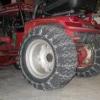-
Similar Content
-
 By bigbuck
By bigbuck
I had a fire in 2019 which destroyed my pole barns and some wheel horse tractors and parts. i'm looking for someone who can use the engine that went thru the fire. It is not pristine but there must be some usable parts
please call George at 517-499-5678 for more info.
-
 By cJ_3D
By cJ_3D
Hey all!
Replacing the drive belt on my 252-h. Anyone know the torque specification for the center screw when I put this pto clutch back on? I know it was on there tight it took a minute for the impact to break it loose. Thanks!
CJ
-
 By bkarp@roadrunner.com
By bkarp@roadrunner.com
my magnum 12 kohler all of a sudden is blowing oil out of the carb. if rings are bad should oil be blowing out of the muffler.thanks for any help brent
-
 By Tinman1962
By Tinman1962
Recently got hold of a 656 it's has a "newer" 61/2 Briggs on it I don't believe that's right any ideas about that
-
 By Little Red Horse
By Little Red Horse
Hey all. I have a Electro 12 with a factory belly blade. It runs* and drives. I had used it to grade my driveway the last 6 yrs. Having moved I'm looking at my options on storing it or selling it. Frankly I have no idea what it is worth. I watched "ISaveTractors" video on 5 things to do with a new to you wheel horse/12hp kohler. (When i got it 6yrs ago) And went thru and did the adjustments and replaced the parts mentioned. It has been a good strong tractor for me until around July of this year. (2023)
*Around July it started dying after running 20-30min. I replaced the carb (Chinese Amazon purchase) with one from isavetractors web site. That seemed to help it idle smoother(the old carbs jets wouldnt adjust), but it still dies at around 20-30min.
So I've got 2 questions.
1. What is it worth? (As-Is) and
2. What do I need to do to fix it?
Thanks yall!
-

